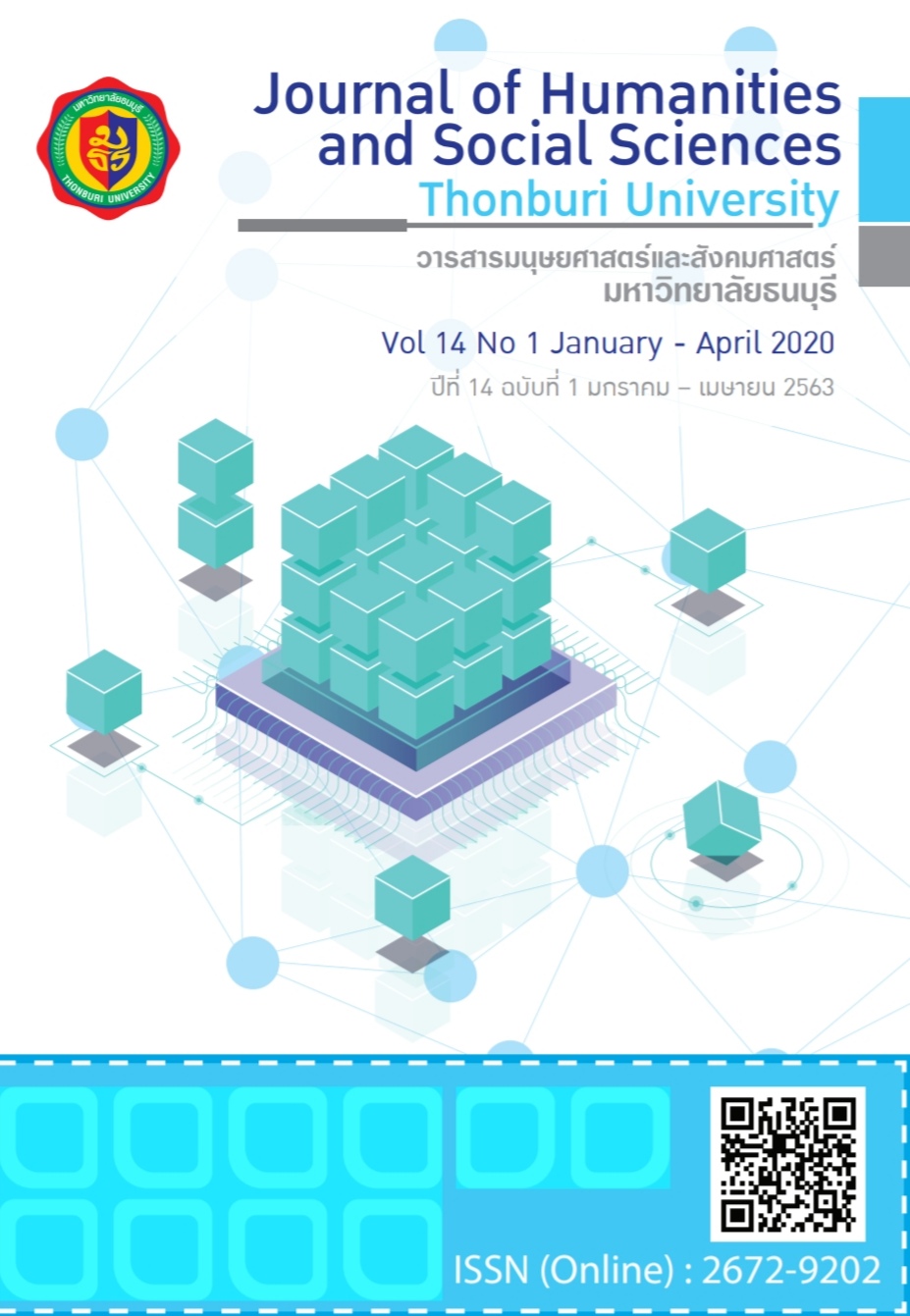กลยุทธ์ที่ส่งเสริมคุณค่าการท่องเที่ยวเชิงพุทธศาสนาในเกาะรัตนโกสินทร์
คำสำคัญ:
กลยุทธ์, ส่งเสริมคุณค่า, ท่องเที่ยวเชิงพุทธศาสนาบทคัดย่อ
การทำวิจัยเรื่อง กลยุทธ์ที่ส่งเสริมคุณค่าการท่องเที่ยวเชิงพุทธศาสนาในเกาะรัตนโกสินทร์ พบว่า พฤติกรรมของนักท่องเที่ยวเดินทางมาท่องเที่ยวมากกว่า 3 ครั้ง คิดเป็นร้อยละ 79.70 เดินทางมาไหว้พระ/เที่ยวชมหาความเพลิดเพลิน คิดเป็นร้อยละ 37.10 เดินทางท่องเที่ยวด้วยตนเอง คิดเป็นร้อยละ 91.10 นิยมเดินทางมาท่องเที่ยววัดพระศรีรัตนศาสดารามมากที่สุด คิดเป็นร้อยละ25.90 กิจกรรมการตลาดการท่องเที่ยวเชิงพุทธศาสนา พบว่า เห็นด้วยในระดับมาก (X= 3.95) และกิจกรรมการเป็นที่พึ่งทางใจ (X= 3.95) กิจกรรมการเข้าร่วมพิธีกรรม (X= 3.76) และเห็นด้วยในระดับปานกลาง ได้แก่ กิจกรรมการปฏิบัติธรรม(X= 3.50)กิจกรรมการสืบทอดพระพุทธศาสนา (X= 3.40) กิจกรรมการพักผ่อนหย่อนใจ (X= 3.39) และกิจกรรมการเช่าวัตถุมงคล (X= 2.71) สำหรับประเด็นที่เห็นด้วยในระดับมากคือ การเข้าร่วมกิจกรรมการกราบสักการะพระพุทธรูป(X= 4.04) การเข้าร่วมกิจกรรมการทำบุญตักบาตร (X= 3.97)การเข้าร่วมกิจกรรมการทำบุญตักบาตร (X= 3.91)การเข้าร่วมกิจกรรมในวันสำคัญทางพุทธศาสนา กลยุทธ์การตลาดการท่องเที่ยวเชิงพุทธศาสนาที่นักท่องเที่ยว มีความพึงพอใจในระดับมาก ในด้านความสะดวกสบายของสถานที่ (X= 3.85) กระบวนการซื้อผลิตภัณฑ์ทางการท่องเที่ยว (X= 3.79) บุคลากรทางการท่องเที่ยว (X= 3.70) กิจกรรมการท่องเที่ยวเชิงพุทธศาสนา (X= 3.66) การส่งเสริมการตลาด (X= 3.61) สิ่งแวดล้อมทางกายภาพ (X= 3.61)5.90 ประสิทธิผลที่ได้จากกลยุทธ์การตลาดที่ส่งเสริมคุณค่าการท่องเที่ยวเชิงพุทธศาสนาตามลำดับคือด้านภาพลักษณ์ (X= 4.06) การรับรู้คุณค่าทางพระพุทธศาสนา (X= 4.03) ความพึงพอใจ (X= 3.90)
เอกสารอ้างอิง
อัครพงศ์ อั้นทอง; และ มิ่งสรรพ์ ขาวสอาด (2553). ภาพลักษณ์และพฤติกรรมนักท่องเที่ยวต่างชาติภายใต้สถานการณ์วิกฤตการเมืองไท. วารสารเศรษฐศาสตร์ธรรมศาสตร์ มหาวิทยาลัยกรมศิลปากร. 28(3): 55-98.
สุภาพร วรพล. (2546). แหล่งท่องเที่ยวทางศิลปกรรม. จุลสารการท่องเที่ยว. 22 (3): 46-63.
กิตติศักดิ์ กลิ่นหมื่นไวย. (2561). การศึกษาศักยภาพและสร้างรูปแบบเส้นทางการท่องเที่ยวชุมชนและมัคคุเทศก์ท้องถิ่นการท่องเที่ยวชุมชนเทศบาลตำบลนาครัว อำเภอแม่ทะ จังหวัดลำปาง. วารสารวิชาการมหาวิทยาลัยธนบุรี. 2 (28): 86.
Baloglu, S., & McCleary, K. W. (1999) A model of destination image formation. Annals of Tourism Research, 35(4): 11-15.
Bosque, I.R.D., & Martin, H.S. (2008). Tourism satisfaction: A cognitive–affective model. Annals of Tourism Research. 35: 551-57.
Brunner, T., Stocklin, M.;& Opwis, K. (2007). Satisfaction, Image and Loyalty: new versus experienced customers. NewYork: Delmar.
Chi, C. G., & Qu, H. (2008). Examining the structural relationships of destination image, tourist satisfaction and destination loyalty: An integrated approach, Tourism management. Journal of Hospitality & Tourism Research, 29(4): 624-636.
Chitty, B., Ward, S., & Chua, C. (2007). An application of the ECSI model as a predictor of satisfaction and loyalty for backpacker hostels. New York: Delmar.
Chon, K. S., (1990). The role of destination image in tourism: A review and discussion, Tourism review, 45(2): 2-9.
Echtner, C. M. and J. R. B. Ritchie. (2003). The Meaning and Measurement of Destination Image. Journal of Tourism Studies. 14(1): 37-48.
Jang, S., Cai, L. A., Morrison, A. M., & O’Leary, J. T., (2006). The effects of travel activities and seasons on expenditure. International Journal of Tourism Research, 7(6): 335-346.
Magistris & Gracia. (2008). The decision to buy organic food products in Southern Italy. n.p.
Makarem & Mudambi. (2007). Satisfaction in technology-enabled service encounters. n.p.
Nellson; & Chadha. (2008). International marketing strategy in the retail banking industry. Canada: The case of ICICI Bank.
Pollack. (2009). Linking the hierarchical service quality model to customer satisfaction and loyalty. np.
Rittichainuwat, B. N., & Chakraborty, G. (2009). Perceived travel risks regarding terrorism and disease: The case of Thailand. Tourism Management, 30(3), 410-418.
Shu, T. C., & Steven, F. I. (2007). Examining the mediating role of festival visitors’ satisfaction in the relationship between service quality and behavioral intentions. Journal of Vacation Marketing, (12), 160-165.
Translated Thai References
Akaraphong, A. & Kaosa-ard,M. (2010). Image and International Tourist Behaviors under Thailand's Political Crisis. Journal of Economy Silpakorn University) 28(3): 55-98. (in Thai)
Arugsomboon, P. (2002). Factors Influencing on the Successful Management of Sothon Wararam Worawihan Temple in Chachoengsao Province. (Master of Business Administration Thesis, Sripatum University). (in Thai)
Klinmuenwai, K. (2018). A Study of Tourism Potential and Creating Community-Based Tourism Program and Local Guides of Nakrow Sob-District Municipality, Mae Tha District, Lampang Province. .Journal of Thonburi University. 12(28): 86. (in Thai)
Woraphon, S. (2003). Artistic tourist attraction. Tourism brochure. 22(3): 46-63.







